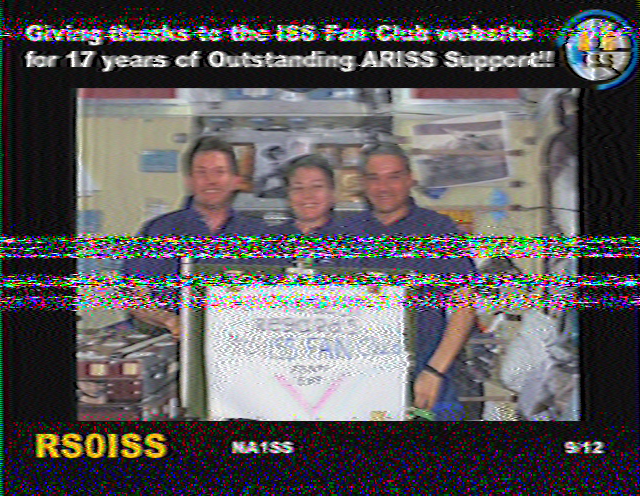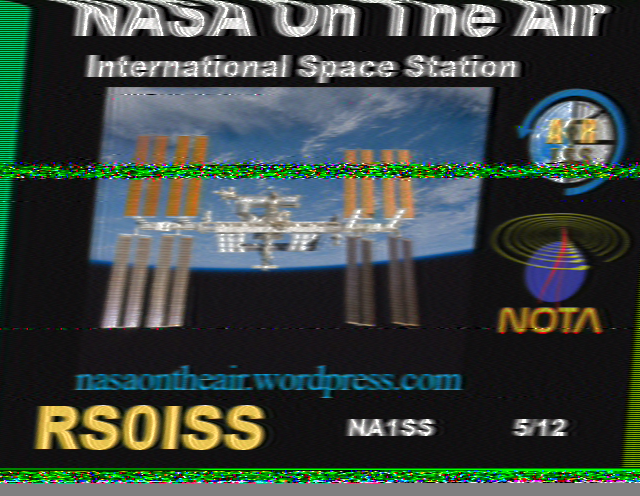ARISS Event Apr, 2022
I was made aware by a kind soul in the club that there was going to be another SSTV event from the ISS. Since the event was during work hours I brought a radio in to work to see how I could do this time and if I could get some work friends excited about it. Unfortunately its was raining so I ended up sheltering under the shipping dock overhang. The passes from Heaven's Above (they've been accurate so far) are below for reference.
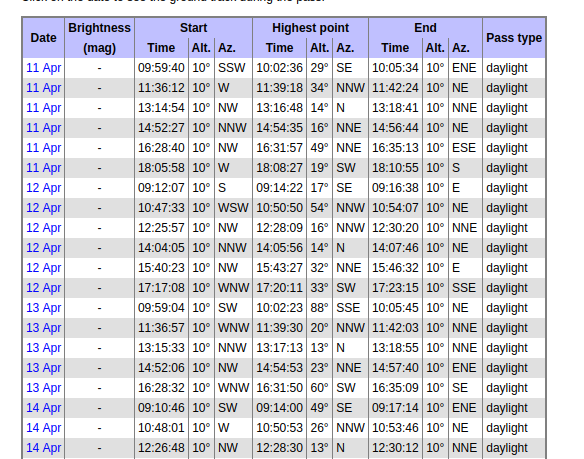 These were both captured with the stock rubber ducky that came with the Yaesu FT-60. I actually took off my high gain Nagoya antenna that I usually have on this radio because its just easier to pack without it if I'm bringing the radio into work. As to orientation what I do is I have the phone in one hand and the radio in the other tilted toward each other slightly, with the squelch all the way off and I listen for tones. As soon as I hear any tones I make sure Robot36 is recording and then if I hear static over the tones I move (my body, keeping the two devices relatively stationary) slowly until I hear a clearer tone. In the case of the 2nd image from the 3:40pm pass I was facing SW with the antenna at about a 45 deg angle relative to the ground in that direction. This is mainly just because it was easier to see the screen on the phone with the glare outside rather than any consideration about best reception. As the ISS goes over (it being day I cannot see it, but I do keep note of the time relative to the calculated pass over times from Heaven's Above) I ended up rotating more to the West but kept the angle relative to ground about the same (comfort and readability). When the static increased and simple horizontal movement didn't improve it, thats when I will try to rotate the device pair in the vertical direction to get clear tones. I might end up holding them in such a way that I can no longer read the screen - the goal is clear tones. Its less "figuring out the right angle" and more "move around slowly until I get the clearest audio" type of thing.
These were both captured with the stock rubber ducky that came with the Yaesu FT-60. I actually took off my high gain Nagoya antenna that I usually have on this radio because its just easier to pack without it if I'm bringing the radio into work. As to orientation what I do is I have the phone in one hand and the radio in the other tilted toward each other slightly, with the squelch all the way off and I listen for tones. As soon as I hear any tones I make sure Robot36 is recording and then if I hear static over the tones I move (my body, keeping the two devices relatively stationary) slowly until I hear a clearer tone. In the case of the 2nd image from the 3:40pm pass I was facing SW with the antenna at about a 45 deg angle relative to the ground in that direction. This is mainly just because it was easier to see the screen on the phone with the glare outside rather than any consideration about best reception. As the ISS goes over (it being day I cannot see it, but I do keep note of the time relative to the calculated pass over times from Heaven's Above) I ended up rotating more to the West but kept the angle relative to ground about the same (comfort and readability). When the static increased and simple horizontal movement didn't improve it, thats when I will try to rotate the device pair in the vertical direction to get clear tones. I might end up holding them in such a way that I can no longer read the screen - the goal is clear tones. Its less "figuring out the right angle" and more "move around slowly until I get the clearest audio" type of thing.
As I explained to interested parties at work who wondered what the heck I was doing: its like fishing for geeks.
The pass on Apr 12 at 10:47am
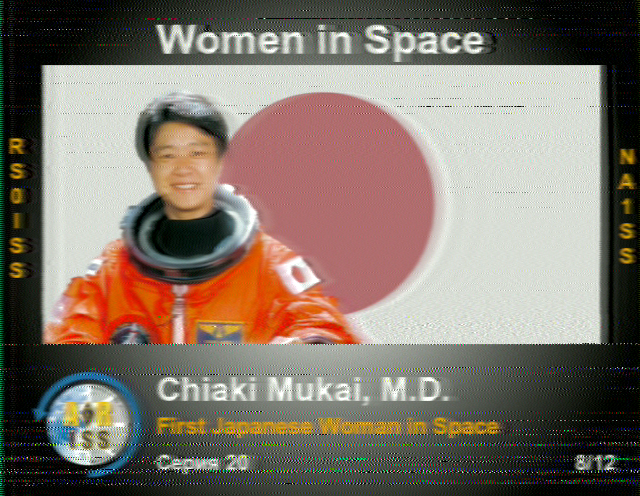
The pass on Apr 12 at 3:40pm
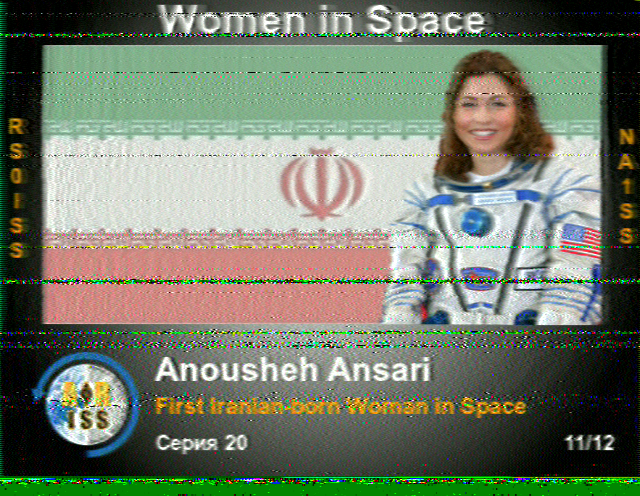
ARISS Event Feb, 2019
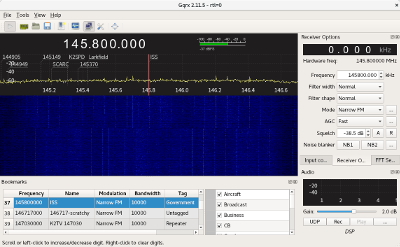 AMSAT (Amateur Radio in Space) announced that the ISS would be participating in another SSTV event over the weekend of Feb 8 - 10, 2019. Hams would be able to receive images sent from the station on 2 meters at 145.800 MHz with the PD120 mode. PD120 is an old SSTV mode from 1997 and described by its inventor G4IJE at classicsstv.com.
AMSAT (Amateur Radio in Space) announced that the ISS would be participating in another SSTV event over the weekend of Feb 8 - 10, 2019. Hams would be able to receive images sent from the station on 2 meters at 145.800 MHz with the PD120 mode. PD120 is an old SSTV mode from 1997 and described by its inventor G4IJE at classicsstv.com.
To be able to receive the images, I hope to use my RTL-SDR dongle with QSSTV (mentioned recently in a video by KB9RLW). I started by installing QSSTV in Ubuntu following the installation instructions provided on the QSSTV website. Many programs in Ubuntu can be installed easily through their software store, but this program is not maintained by Ubuntu so you have to download it and compile it. This isn't hard, but does require some work in the command line. I had no errors or problems in the compile and the program started right up. QSSTV needs to get audio from somewhere. I launched pulseaudio (which is like an audio mixer in Linux) and then in the configuration of QSSTV, on the sound tab, I have it set to Pulseaudio. It didn't "hear" anything yet, so I needed to run GQRX to receive audio from my connected RTL-SDR and then pulseaudio could pass that sound to QSSTV. I enabled receive (the little play button on QSSTV) and tested by tuning GQRX to some random station which was broadcasting and then I could see activity in the QSSTV screen. No idea if I'll be able to receive signal from the ISS yet. In GQRX I am always accidentally changing the offset so I have to remember to reset that (at upper right) and make sure I'm on the frequency I want to be on.
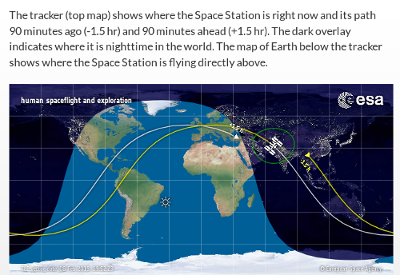 I then used the NASA website tool spotthestation.nasa.gov to determine when the ISS would be overhead. It looked from their map that it would be passing by (out over the Atlantic but at least closest pass to NYC) around 10:45 am on Sat. Feb 9. This screenshot is from around 9:30 am maybe 15 minutes after the +1.5 h mark had passed NY.
I then used the NASA website tool spotthestation.nasa.gov to determine when the ISS would be overhead. It looked from their map that it would be passing by (out over the Atlantic but at least closest pass to NYC) around 10:45 am on Sat. Feb 9. This screenshot is from around 9:30 am maybe 15 minutes after the +1.5 h mark had passed NY.
Right on time I started to see signal on frequency and soon QSSTV was decoding something. The end result for this pass wasn't stellar (heh, see what I did there?) but its something I received from the ISS! Here's what my desktop looked like when it first started coming through:
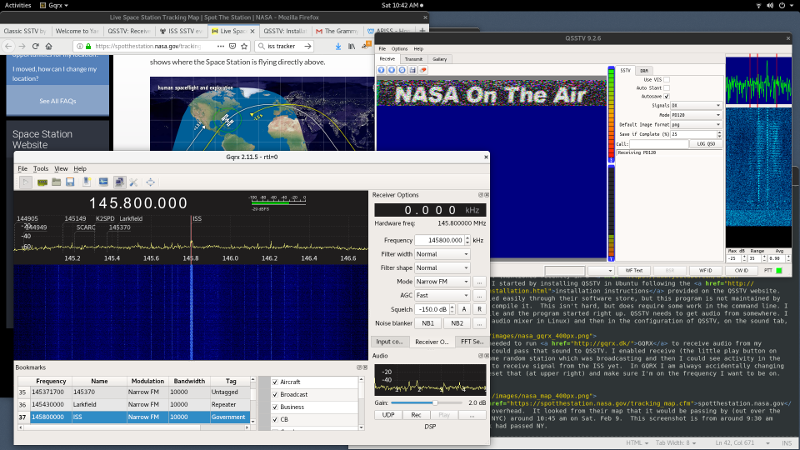
My resulting image. A little disappointing, but I have another chance to get something in about an hour and a half. Its a bit cold or I'd set up the antenna outside but this is what I got with my Comet GP-3 set up inside the shack. You can see some (much better quality) images submitted by others at spaceflightsoftware.com.
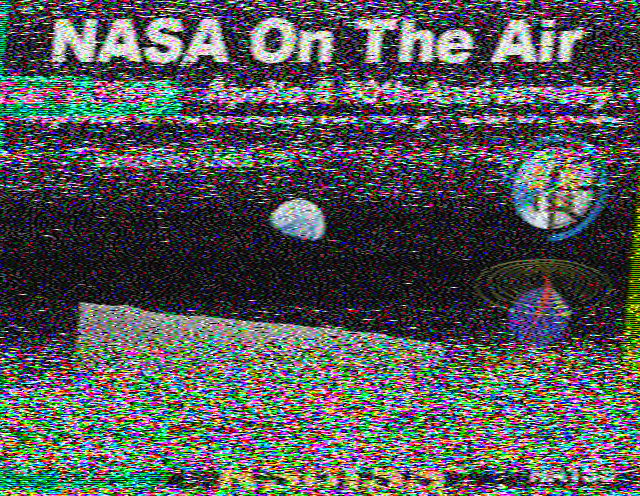
The second pass of the ISS was North of NY at about 12:20pm and I decided to try a different method. I disconnected the RTL-SDR and connected up the Kenwood TM-V71A using an audio cable to the mic input on my PC.
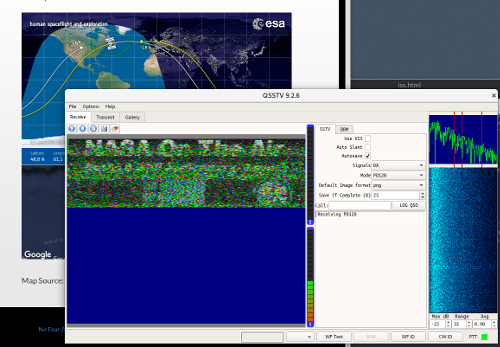 This was a bit tricky given that the PC I'm using has a dual mic/headphone connector TRRS and the male to male 1/8" audio connector I have from the Kenwood is TRS.
This was a bit tricky given that the PC I'm using has a dual mic/headphone connector TRRS and the male to male 1/8" audio connector I have from the Kenwood is TRS.
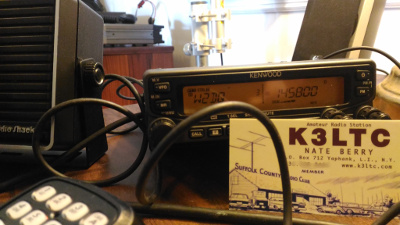 I ended up using a Hauppauge USB-Live2 analog video digitizer I happened to have and a couple adapters to make it work, but if I were to do this again I'd probably look into a different solution. Pulseaudio "heard" the Hauppauge signal, and QSSTV "heard" it through that so no need for GQRX.
The satellite map showed that the ISS was right at our latitude and I was fiddling with the back of the Kenwood trying to figure out if I was plugged into the right audio output (there are two since it can monitor two channels at once and has a split VFO screen) when I suddenly heard data tones. Plugging the audio cable back in quick I was able to capture just a tiny portion of the image before the ISS was passing Greenland and I lost the signal.
I ended up using a Hauppauge USB-Live2 analog video digitizer I happened to have and a couple adapters to make it work, but if I were to do this again I'd probably look into a different solution. Pulseaudio "heard" the Hauppauge signal, and QSSTV "heard" it through that so no need for GQRX.
The satellite map showed that the ISS was right at our latitude and I was fiddling with the back of the Kenwood trying to figure out if I was plugged into the right audio output (there are two since it can monitor two channels at once and has a split VFO screen) when I suddenly heard data tones. Plugging the audio cable back in quick I was able to capture just a tiny portion of the image before the ISS was passing Greenland and I lost the signal.
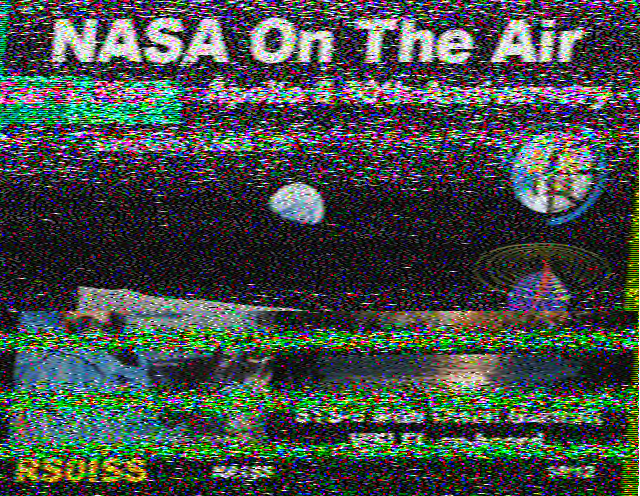 In the third pass at about 3:30 pm I was able to get part of the bottom of the picture. I combined them into this composite (I didn't get this entire image in one pass). I think I'm going to switch back to using the RTL-SDR for the next pass.
In the third pass at about 3:30 pm I was able to get part of the bottom of the picture. I combined them into this composite (I didn't get this entire image in one pass). I think I'm going to switch back to using the RTL-SDR for the next pass.
After reading some tips on the AMSAT-UK site, I decided to try using a different antenna. They suggest using a 1/4 wave antenna (like my little Nagoya that I use with my Baofeng and since I don't have the necessary adapters to use that with my RTL-SDR I would have to connect that up as I did the Kenwood. For whatever reason I didn't pick up any signal at all on that pass (around 9:45am on Sun Feb 10) so I decided to move outside with the Baofeng for the next one. Since I wasn't going to be able to have the radio connected to a computer, I planned to just acquire the audio and process it later. This pass was to be directly overhead so signal should be good. The only way I could figure out to record the audio was to hold my phone next to the radio (set with Squelch completely off) and record the tones with a voice recorder app. This time the signal was strong and quieting (no background noise heard) and I was able to capture most of the signal (I lost it at one point and had to re-orient the antenna to get it back). Here's the result!
There was a little more to this method since at least on Linux I had to play the audio file (in VLC) to a NULL device (in pulseaudio) and QSSTV had to record from that device, but it was all well documented by Kristijan, M0NKC at chonky.net
Feb 15, 2019
Because of a problem on the ISS there was low signal output from the ISS last weekend, so they announced that they would be doing a repeat event this weekend (Feb 15-17)! I was able to be outside (with my baofeng + cell phone setup) for two passes on the morning of Feb 15, and acquired enough audio data for the following images. The first one was a little after 9am and I wasn't able to get decent signal for any length of time. The ISS was passing to our South on that pass according to the ESA Isstracker. I actually wasn't able to decode anything from that pass at all.
For the next pass (at about 10:30am), I stood on the North side of the building as the ISS was passing to our North according to the tracker (see link above) and I got MUCH better signal this time. I caught the tail end of one transmission (the first one below), and then the entirety of another transmission. There was still occassional static interference (unknown if this was a problem on ISS or something in my area) but I was able to acquire the 2nd image in full.
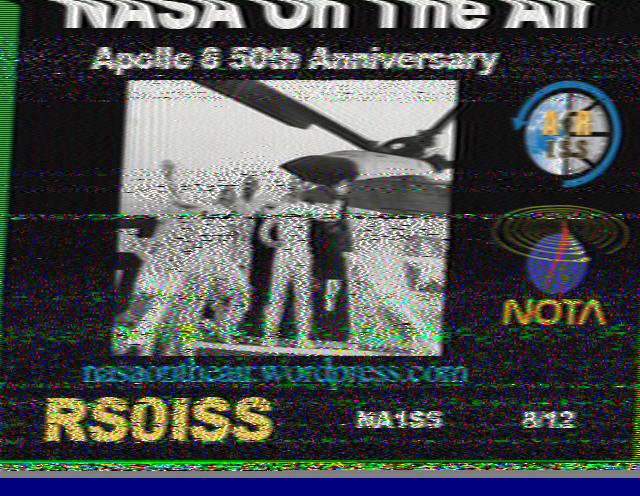
At noon I went out to a field behind where I work and was able to get good strong signal for this pass. I acquired one full image using the same method as the previous two.
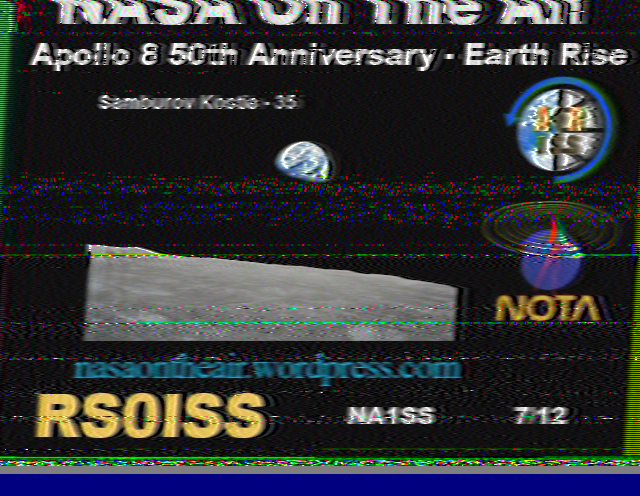
Ran out to the field for another pass on Feb 15 at 1:40pm. This time the ISS appeared on the ESA map as high across the US right along the border with Canada for most of the trip. I was able to get two images. The second one I purposely started recording *before* I heard any tones which created a nicely straight image at the top before the ISS passed out over the Atlantic over Newfoundland.
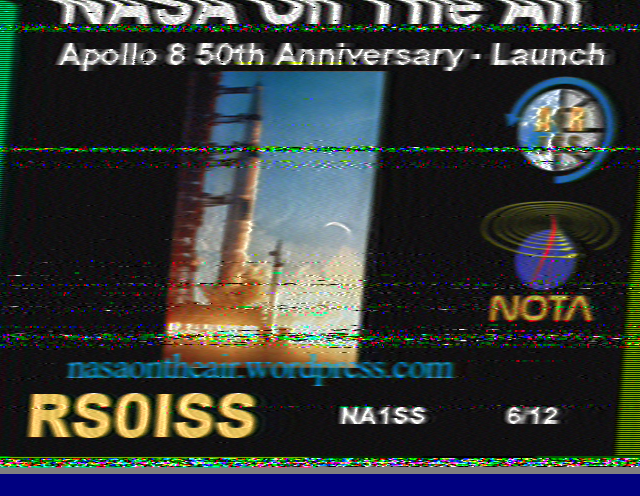
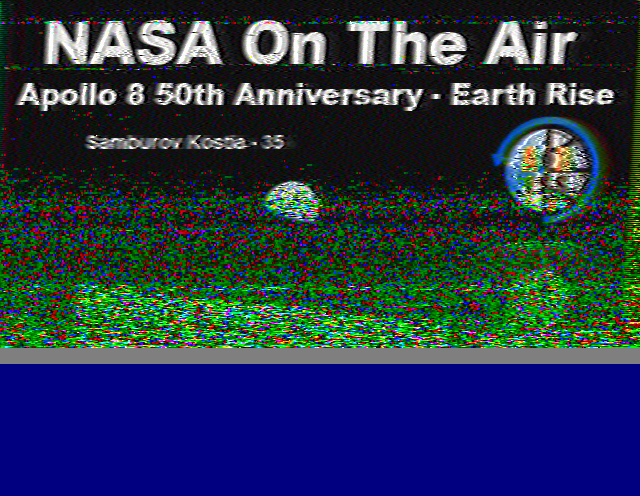
Feb 16, 2019
I ran a test on the 9:30am EST pass where I live streamed my indoor setup (a full wave Comet antenna connected through an RTL-SDR direct to the PC running Ubuntu with QSSTV) while I also went outside with a small Baofeng with a 1/4 wave Nagoya whip and recorded the audio tones on my cellphone. With the small handheld I was able to move ever so slightly to get the best signal as the satellite passed over, and I got a great result. The image from inside was acceptable, but had a lot of noise.
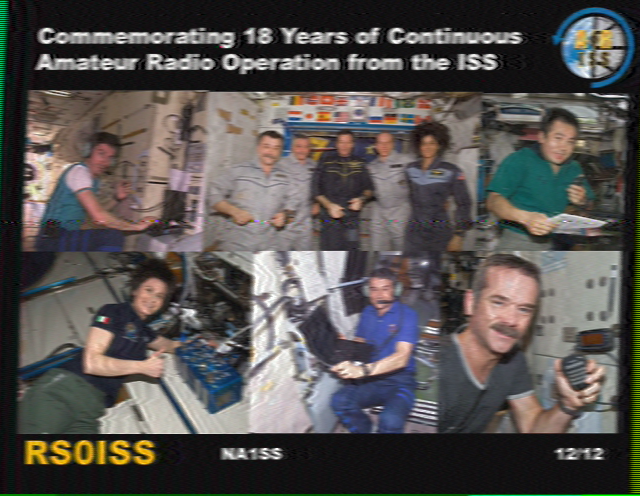
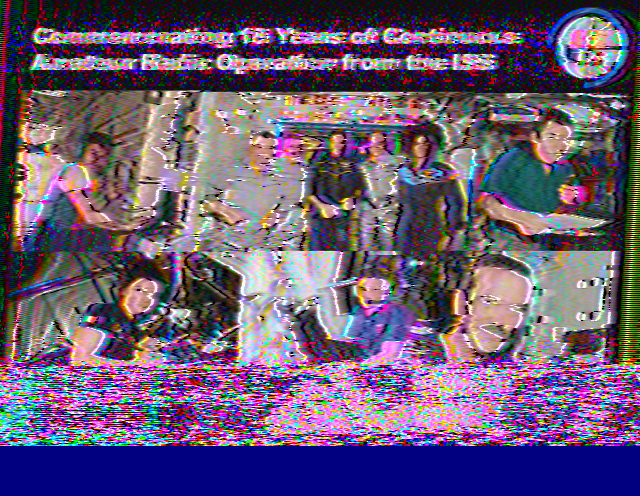 For the 11am pass I went out to the car where I have a Comet SBB5 (5/8 wave?) set up on a trunk lid mount. I used my Radio Shack scanner (with a BNC to SO-239 adapter) and recorded on my phone.
There was a lot of static and I caught only the tail end of one transmission (an image I didn't have yet) and almost all of the second before the ISS was out of range, but the obvious problem is with a fixed antenna I can't make those minor corrections to get the best signal like I can with a handheld.
For the 11am pass I went out to the car where I have a Comet SBB5 (5/8 wave?) set up on a trunk lid mount. I used my Radio Shack scanner (with a BNC to SO-239 adapter) and recorded on my phone.
There was a lot of static and I caught only the tail end of one transmission (an image I didn't have yet) and almost all of the second before the ISS was out of range, but the obvious problem is with a fixed antenna I can't make those minor corrections to get the best signal like I can with a handheld.
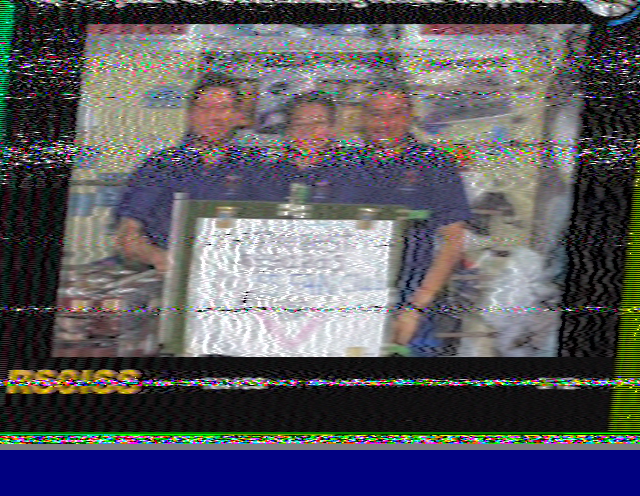 I missed the pass over at lunch time, and almost missed the one at 2:20pm, but I happened to glance at the ISS tracker and saw that it was just moving into range so I grabbed the Baofeng and phone and managed catch most of the first transmission from my dining room and then ran outside in time to catch all of the second image. Both had a fair amount of noise, but were recognizable and ones I hadn't gotten before.
I missed the pass over at lunch time, and almost missed the one at 2:20pm, but I happened to glance at the ISS tracker and saw that it was just moving into range so I grabbed the Baofeng and phone and managed catch most of the first transmission from my dining room and then ran outside in time to catch all of the second image. Both had a fair amount of noise, but were recognizable and ones I hadn't gotten before.
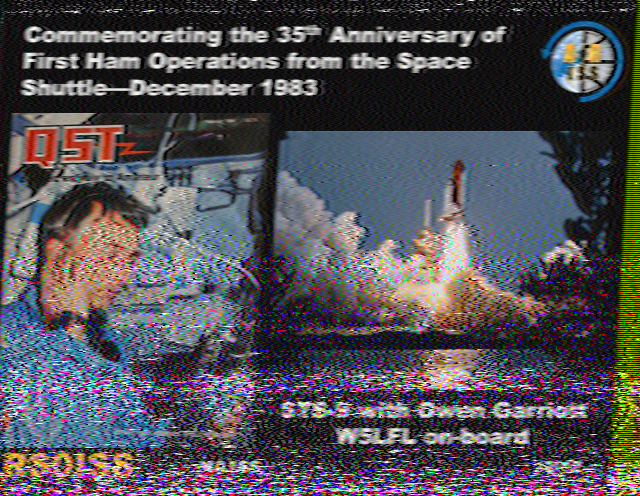
I went outside at 4pm and managed to snag one complete image which, while it had some noise, was otherwise readable. Always nice to get a new image, having gotten a number of duplicates so far.
